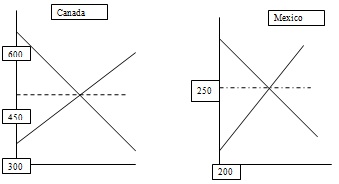Assignment:
1. Consider two countries, Canada and Mexico, with the following domestic demand and supply curves and equilibrium points for TV set. Answer the following questions.

a. Draw export supply and import demand curves for TV sets in the international market.
b. What is the price range within which the international equilibrium price of TV falls?
c. If the international market equilibrium price is $299, how many TV sets will be supplied by Canadian producers?
d. If the world price is $400, which country gains the most after trade? Explain why.
2. Read the accompanying article (Labor and Capital in the Global Economy, Winter 2017, Democracy Journal, by Kimberly Clausing) and answer the following questions. Limit your answers to not more than two pages (double spaced).
It is noted that "Economists focusing on the corporate sector have found that the labor share of income declined by 8 percentage points over the period 1980-2012, from 65 to 57 percent."
a. According to the article, what are the major causes of this decline in the labor share of income? Describe each briefly.
b. Some scholars argue that this characterization is not valid, and it is impossible to verify such a decline. What are the reasons that scholars provide to invalidate such a trend?
Readings:
1. Global Economy
By Kimbrly Clausing
2. International Trade
By Robert C. Feenstra and Alan M. Taylor